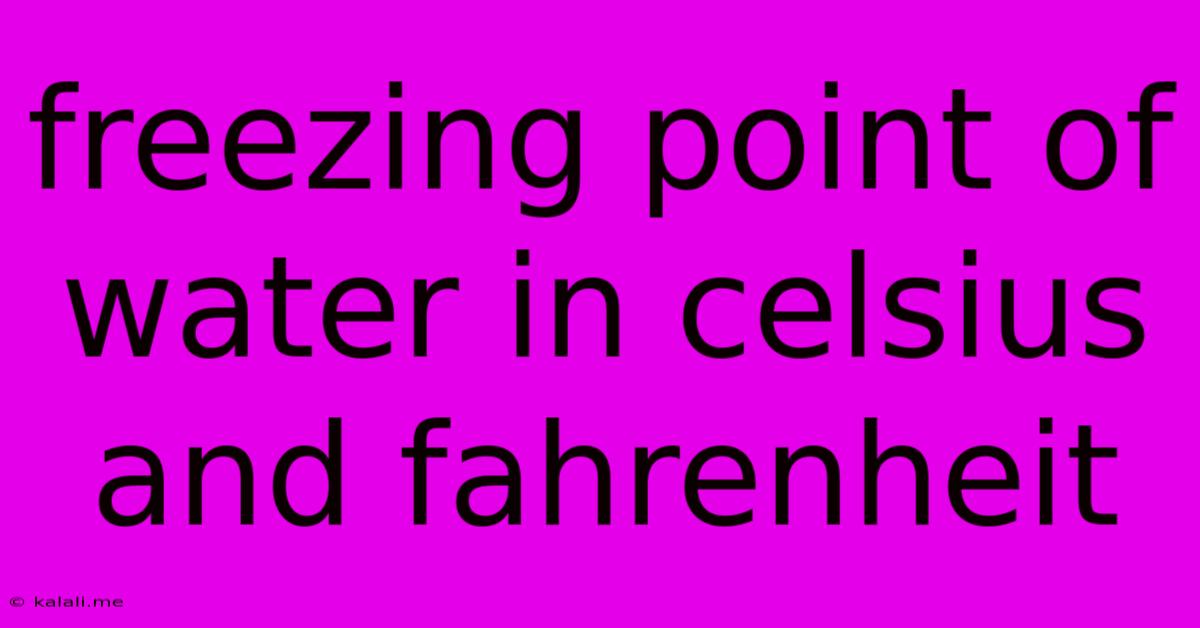Freezing Point Of Water In Celsius And Fahrenheit
Kalali
Jun 15, 2025 · 3 min read

Table of Contents
The Freezing Point of Water: Celsius vs. Fahrenheit
Water, the elixir of life, exhibits a crucial property that impacts our daily lives and scientific understanding: its freezing point. This article will delve into the freezing point of water, exploring its values in both Celsius and Fahrenheit scales, and examining the underlying scientific principles. Understanding this fundamental property is crucial for numerous applications, from everyday activities like freezing food to complex scientific experiments.
What is the Freezing Point of Water?
The freezing point of water is the temperature at which water transitions from its liquid state to its solid state (ice). This phase transition occurs at 0 degrees Celsius (0°C), which is equivalent to 32 degrees Fahrenheit (32°F). This seemingly simple fact underpins countless processes and applications in various fields.
Why Different Scales?
The difference in numerical values stems from the different scales used to measure temperature. The Celsius scale, also known as the centigrade scale, uses the freezing and boiling points of water as its reference points: 0°C and 100°C respectively. The Fahrenheit scale, on the other hand, has different reference points, resulting in a different numerical representation for the freezing point of water.
Understanding the Phase Transition
The freezing point of water isn't just a number; it represents a significant physical change. As water cools, its molecules lose kinetic energy, slowing their movement. Below 0°C, the attractive forces between water molecules overcome their kinetic energy, causing them to form a rigid, crystalline structure—ice. This process releases latent heat, meaning energy is released during the phase change, preventing a sudden drop in temperature.
This phase transition is reversible. Applying heat to ice will increase the kinetic energy of the water molecules, eventually breaking the crystalline structure and transitioning back to liquid water at 0°C. This process, called melting, also absorbs latent heat.
Factors Affecting the Freezing Point
While the standard freezing point of water is 0°C/32°F, several factors can slightly influence this value. These include:
- Pressure: Increased pressure can slightly lower the freezing point of water. This is an anomaly, as most substances have their freezing points raised by increased pressure.
- Impurities: Dissolved substances, such as salt, can depress the freezing point of water. This is why salt is used to de-ice roads in winter. The salt lowers the freezing point, allowing the ice to melt at a temperature below 0°C.
- Altitude: At higher altitudes, the atmospheric pressure is lower, which can slightly lower the freezing point of water.
Practical Applications
The freezing point of water is critical in various applications, including:
- Food preservation: Freezing food at temperatures below 0°C inhibits the growth of microorganisms and slows down enzymatic activity, extending its shelf life.
- Ice skating: The pressure exerted by ice skates on the ice lowers the melting point, creating a thin layer of water that facilitates skating.
- HVAC systems: Heating, ventilation, and air conditioning systems rely on the understanding of water's phase transitions to regulate temperature and humidity.
- Scientific research: The freezing point of water serves as a fundamental reference point in numerous scientific experiments and calibrations.
In conclusion, the freezing point of water, 0°C or 32°F, is more than just a temperature; it’s a fundamental property with far-reaching implications across various scientific disciplines and everyday life. Understanding this crucial point allows for better appreciation of the world around us and the many processes that depend on this simple, yet profound, phase transition.
Latest Posts
Latest Posts
-
What Is The Lcm Of 4 6 9
Jun 16, 2025
-
What Is The Least Common Multiple Of 20 And 18
Jun 16, 2025
-
What Is The Least Common Multiple Of 30 And 45
Jun 16, 2025
-
Cm Of Water To Mm Of Hg
Jun 16, 2025
-
Which Of The Following Can Lead To A Tsunami
Jun 16, 2025
Related Post
Thank you for visiting our website which covers about Freezing Point Of Water In Celsius And Fahrenheit . We hope the information provided has been useful to you. Feel free to contact us if you have any questions or need further assistance. See you next time and don't miss to bookmark.